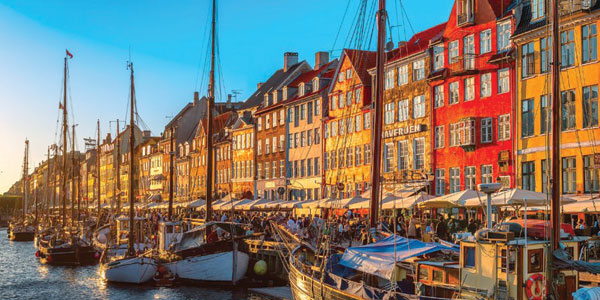
By Jorge Ramos
It’s always the same: Whenever I ask people which country is the happiest in the world, they say, “Mine,” then follow it up with a string of complaints and problems.
But according to surveys, one of the world’s truly happiest countries is Denmark. It ranked No. 1 in 2016, and second this year, according to a data published by the United Nations.
I visited Denmark a few months ago, and I didn’t see any Danes dancing on the streets. They don’t hug or kiss each other very often. The gray skies and cold rain don’t make you feel very festive, either. But the people of Denmark do have a high standard of living, and enjoy a great quality of life.
Let’s start with the bicycles. When a society focuses more on bike traffic than on automobile traffic — and offers perfectly protected and signaled roads like the ones I saw in Copenhagen — it means that it has both the environment and inhabitants’ health in mind when crafting policy. Being one of the top cycling countries worldwide has its advantages. There is a clear sense of equality in place, and a sort of meritocracy as well: The faster you pedal, the faster you go. And I noticed that Danes tended to leave their bikes outside, without locks.
Almost half of Denmark’s Parliament is made up of women, and there is a sort of national pride in the fact that the children of Margrethe II, the queen of Denmark, attend a public school, and get there on their bikes, without nannies or bodyguards. And being in the spotlight doesn’t seem to be very appealing to people in this country.
While Denmark has its share of anti-immigrant and ultra-right-wing politicians like anywhere else, simplicity and good judgment tend to prevail over vulgarity and raucousness. A sense of community takes precedence over blind nationalism.
Danish people take care of each other from the minute they are born until the day they die. And their social welfare system works
They are generous with their vacations, go home from work early and arrive on time to appointments. New parents enjoy one year of leave to stay home with their babies.
Of course, all this comes with a price. Danes joke that they work for themselves Monday and Tuesday, and on Wednesday, Thursday and Friday to pay taxes. But everyone has signed the social contract: They pay their fair share in taxes, and in exchange they get a good education and are taken care of if they become ill.
This country is also known for its lack of corruption among public officials. People here don’t approve of a government paying for politicians’ personal expenses (hotels, restaurants, cigarettes, transportation, etc.). This I learned from Gabriel, my wonderful Argentinian walking-tour guide. (Also, if you like the service you receive in Denmark, you tip. Otherwise you just walk away.)
It seems that the Danes have mastered one of the most difficult lessons in life: Make the best of everything, right where you are. In fact, they have a word to describe this attitude: “hygge.” There is no exact translation, but it means creating an atmosphere of well being in the present moment, wherever you might be.
Danes have made their country work for its people. Nobody is in danger of being killed on the street, nobody is starving, everybody has the right to study and enjoys freedom of speech. This is a country where women have the same opportunities as men; where the government does whatever it takes to keep people satisfied so they won’t want to leave; where falling ill or retiring are not death sentences; where there is not an abyss between the rich and the poor; where leaders are elected by everyone, and you are not discriminated against for your skin color.
Unfortunately, Danish happiness is not contagious, nor is it exportable. Other countries could learn valuable lessons from Denmark.
(Jorge Ramos, an Emmy Award-winning journalist, is a news anchor on Univision.)
______________________________________________________________________________________________
El País Más Feliz
No falla. Cuando le pregunto a la gente cuál es el país más feliz del mundo, casi siempre me responden: “El mío.” Pero luego sigue una letanía de quejas y problemas.
Técnicamente, uno de los países más felices del mundo es Dinamarca. Fue el número uno en el 2016 y el número dos en este 2017, según un estudio publicado por Naciones Unidas. Y éstas son las notas de mi última visita hace unos meses.
No vi a los daneses bailando en la calle, ni riéndose a carcajadas. Tampoco se abrazaban, ni se besaban mucho. El cielo gris y la lluvia fría no fomentaban un ambiente de fiesta, pero sí había muchas señales de que vivían bien.
Empecemos por las bicicletas. Cuando un país cuida a sus ciclistas más que a sus autos — con vías perfectamente protegidas y señalizadas como las que vi en Copenhague — es que tiene bien amueblada la cabeza. De entrada te dice que cuida el medio ambiente y la salud de sus habitantes.
Ser uno de los países más bicicleteros del mundo tiene sus ventajas. Hay un claro sentido de igualdad. Existe una especie de meritocracia; va más rápido quién tiene las mejores piernas y hace más esfuerzo, no el que compró la bicicleta más cara. Y las dejan fuera de los lugares públicos sin candado.
Los daneses trabajan duro para ser parejos. Casi la mitad de su parlamento está compuesto por mujeres, y hay una especie de orgullo nacional en el hecho de que a veces a los nietos de la reina Margarita II los llevan en bicicleta a una escuela pública, sin niñeras ni guardaespaldas.
En este país no está bien visto llamar la atención. Y aunque también hay políticos antiinmigrantes y de ultraderecha, la sencillez y la prudencia suelen vencer a los vulgares y estridentes. El sentido de comunidad triunfa sobre los personalismos.
El país que nos dio los juguetes Lego y que pone todos los productos del planeta en sus contenedores marítimos, sabe diseñar estructuras. Los daneses se cuidan desde que nacen hasta que se mueren. Y el sistema funciona. Son generosos con sus vacaciones, salen temprano del trabajo, son puntuales en sus citas, y luego de dar a luz, la madre y el padre pasan hasta un año con su bebé.
Y a los fumadores los encierran. Literalmente. En el aeropuerto de Copenhague vi jaulas de vidrio, como en zoológico, donde uno puede ver cómo se ahogan los fumadores. Es, sospecho, una humillación/lección pública.
Claro, todo esto cuesta. La broma (de la que nadie se ríe) es que muchos daneses trabajan para ellos lunes y martes, y para el gobierno miércoles, jueves y viernes. Pero el contrato social está firmado: Yo te pago muchos impuestos y a cambio tú me das escuela, salud y ayuda si no me va muy bien en la vida.
Ahora, agárrense. Este país tiene fama de cero corrupción. Cero trampas. No se ve bien que el gobierno pague por gastos personales — hoteles, restaurantes, cigarros, transporte — de sus políticos. (Compadre ¿qué tal un cursito de ética danesa para nuestros políticos latinoamericanos?)
Bueno, muchas de estas cosas me las contó Gabriel, un genial guía argentino de Free Walking Tours. Muy a la danesa, si te gusta el servicio le das propina; si no, te vas y ya.
Dinamarca no es un carnaval. Pero los daneses han aprendido una de las cosas más difíciles de la vida: aprovechar todo lo que existe donde estés. De hecho, esa actitud tiene una palabra: “hygge.” No hay traducción exacta, pero significa crear un ambiente de bienestar con lo que te rodea y en el presente.
El problema es que esta felicidad danesa no es contagiosa. Ni exportable.
Creo, como mencioné al principio, que el mejor país del mundo es el de uno. El que sea, pero donde no te maten en la calle, donde nadie se quede con hambre, donde te dejen estudiar y decir lo que quieras, donde las mujeres tengan las mismas oportunidades que los hombres, donde hagan todo lo posible para que no tengas que emigrar, donde enfermarse o retirarse no sea una sentencia de muerte, donde no haya un abismo entre ricos y pobres, donde sus líderes sean escogidos por todos, donde el corrupto acabe en la cárcel y donde no te discriminen por tu piel.
Es como hacer un castillo con Legos. Despacito y pieza sobre pieza. En lo que llegamos ahí, está Dinamarca para aprender.









